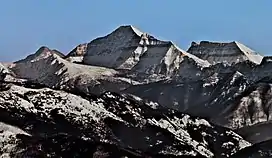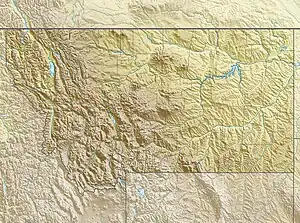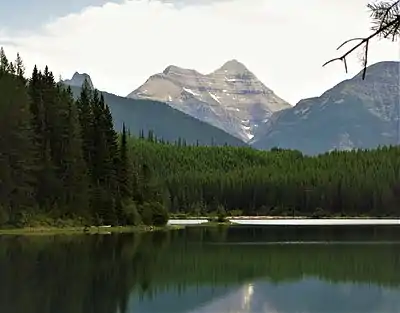| Mount Stimson | |
|---|---|
 Mount Stimson's west aspect, centered (Mount Pinchot to right) | |
| Highest point | |
| Elevation | 10,147 ft (3,093 m)[1] |
| Prominence | 4,382 ft (1,336 m)[1] |
| Coordinates | 48°30′51″N 113°36′37″W / 48.51417°N 113.61028°W[2] |
| Geography | |
 Mount Stimson Location in Montana  Mount Stimson Location in the United States | |
| Location | Flathead County, Montana, U.S. |
| Parent range | Lewis Range |
| Topo map | USGS Mount Stimson |
| Climbing | |
| First ascent | J. Gordon Edwards and Alice Edwards (1951) and likely earlier |
| Easiest route | Hike/scramble (Class 3/4) |
Mount Stimson (10,147 feet (3,093 m)) is the second highest peak in Glacier National Park, located in Montana, United States. It is part of the Lewis Range, which spans much of the park.[3] It is located in the remote southwestern portion of the park, approximately 5 miles (8.0 km) west of the Continental Divide and 12 miles (19 km) southeast of Lake McDonald. It is drained by Pinchot Creek (on the south) and Nyack Creek (on the other sides), both of which flow into the Middle Fork of the Flathead River. The mountain is named for Henry L. Stimson (1867–1950), former U.S. Secretary of State and twice Secretary of War, who hiked and assisted George Bird Grinnell survey the area in and around Glacier National Park in the 1890s, and supported efforts to establish the national park.
Notability
Mount Stimson is notable for its large, steep rise above local terrain. For example, its northwest face rises over 6,200 feet (1,900 m) from Nyack Creek in only 1.8 miles (2.9 km). This makes it "truly a monster of a mountain."[4] It is also notable for its isolation; it is one of the farthest peaks from a roadhead in the park.

Climate
| Climate data for Mount Stimson 48.5156 N, 113.6078 W, Elevation: 9,098 ft (2,773 m) (1991–2020 normals) | |||||||||||||
|---|---|---|---|---|---|---|---|---|---|---|---|---|---|
| Month | Jan | Feb | Mar | Apr | May | Jun | Jul | Aug | Sep | Oct | Nov | Dec | Year |
| Mean daily maximum °F (°C) | 22.6 (−5.2) |
22.2 (−5.4) |
26.1 (−3.3) |
31.1 (−0.5) |
40.5 (4.7) |
48.5 (9.2) |
59.5 (15.3) |
60.0 (15.6) |
51.7 (10.9) |
38.4 (3.6) |
26.4 (−3.1) |
21.3 (−5.9) |
37.4 (3.0) |
| Daily mean °F (°C) | 16.1 (−8.8) |
14.4 (−9.8) |
17.2 (−8.2) |
21.6 (−5.8) |
30.2 (−1.0) |
37.4 (3.0) |
46.7 (8.2) |
47.3 (8.5) |
39.4 (4.1) |
28.9 (−1.7) |
20.1 (−6.6) |
15.2 (−9.3) |
27.9 (−2.3) |
| Mean daily minimum °F (°C) | 9.6 (−12.4) |
6.6 (−14.1) |
8.3 (−13.2) |
12.1 (−11.1) |
19.9 (−6.7) |
26.3 (−3.2) |
33.9 (1.1) |
34.7 (1.5) |
27.1 (−2.7) |
19.5 (−6.9) |
13.7 (−10.2) |
9.0 (−12.8) |
18.4 (−7.6) |
| Average precipitation inches (mm) | 9.71 (247) |
8.34 (212) |
8.67 (220) |
7.20 (183) |
7.18 (182) |
8.21 (209) |
2.83 (72) |
2.99 (76) |
4.72 (120) |
6.98 (177) |
10.45 (265) |
9.92 (252) |
87.2 (2,215) |
| Source: PRISM Climate Group[5] | |||||||||||||
History
The first recorded ascent of Mount Stimson was in 1951, by J. Gordon Edwards and Alice Edwards; however they found clear evidence of a previous ascent. The standard route of ascent is the West or Northwest Face Route, starting from Nyack Creek. A backpacking trail runs along Nyack Creek, providing access; however the National Park Service warns that this is a more brushy and isolated trail than in other areas of the park, with numerous unbridged stream crossings.[6] As in the rest of the park, grizzly bears are an issue as well.[7] The climbing route begins with "tiresome uphill bushwhacking...for possibly three hours" leading to alternating slopes and cliffs (Grades 3 and 4).[4] Other routes on the peak include the Southeast Spur from Martha's Basin and the Pinchot Creek Route from the south.

See also
References
- 1 2 "Mount Stimson, Montana". Peakbagger.com. Retrieved May 24, 2018.
- ↑ "Mount Stimson". Geographic Names Information System. United States Geological Survey, United States Department of the Interior. Retrieved May 24, 2018.
- ↑ Mount Stimson, MT (Map). TopoQwest (United States Geological Survey Maps). Retrieved May 24, 2018.
- 1 2 Edwards, J. Gordon (1995). A Climbers Guide to Glacier National Park. Falcon. ISBN 0-87842-177-7.
- ↑ "PRISM Climate Group, Oregon State University". PRISM Climate Group, Oregon State University. Retrieved October 4, 2023.
To find the table data on the PRISM website, start by clicking Coordinates (under Location); copy Latitude and Longitude figures from top of table; click Zoom to location; click Precipitation, Minimum temp, Mean temp, Maximum temp; click 30-year normals, 1991-2020; click 800m; click Retrieve Time Series button.
- ↑ "Mount Stimson". SummitPost. Retrieved 2010-05-02.
- ↑ "Glacier NP Backcountry Guide Summer 2010" (PDF). National Park Service. 2010. Retrieved 2010-11-20.
External links
- Mt. Stimson photo: Flickr